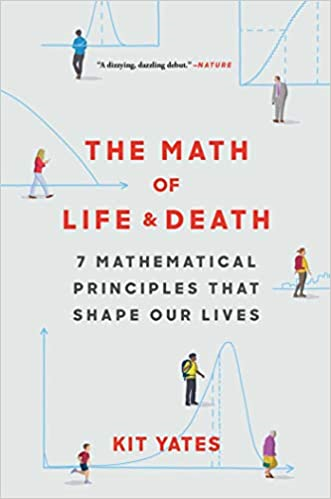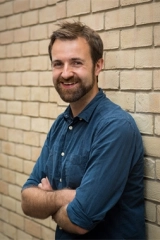
A little math can empower and liberate, says S.Ananthanarayanan.
The recent months have brought ideas of mathematics to common people and made numbers a topic ofworldwide interest. It is interesting that a few months before Covid-19 descended upon the world,London based publishing house, Quercus,brought out a book that deals with just themath that counts in medicine and in epidemics, among other fields where math affects the way society works and communicates.

‘The Maths of life and Death,’ by Kit Yates, senior lecturer in mathematical biology at the University of Bath, hit the stands in September 2019. In 300 racy pages, the book brings out, with stories and yarns, from personal life, anecdotes and world history, to illustrate and entertain, the principles of how things grow and decay, the inside story of medical diagnosis, accounts of how diseases like SARS and Ebola spread and were controlled, the use, and incorrect use, of math in crime detection and in courts, how numbers are manipulated by the media and advertisers, math in government, technology, and ever so many facets of modern living. And the treatment is simple, it is for the lay reader – “not a single equation in these pages,” is a promise in the introduction, and the promise is kept.
The first chapter in the book is on the now familiar subject of exponential growth. But the treatment takes the subject through a range of fields. The first is the classic scam where people are invited to invest in a scheme, and then recruit two others to do likewise. As the pyramid spreads, each person receives payments from several persons lower down, to recover many times what she invested. The trouble is that the number of people involved grows too fast –“in 15 rounds, there would be 10,000 people and in 30 rounds every 7th person on the planet,” says the book. Those who enter the scheme early will make some money, but the greatest numbers are the late entrants, who only lose money to the organisers.
Kit Yates then describes how bacteria grow in a culture, something familiar to us now, and goes on to the way cells of an embryo multiply. And moving out of biology, the working of the atom bomb (with stories about the scientists involved), accidents arising from exponential growth, like Chernobyl, the Ice Bucket campaign, and carbon dating of ancient samples, using the opposite of exponential growth, which is exponential decay- along with a story of how this was used to detect art forgery.

The math of medical diagnosis is the next subject. The message is math, but the examples are contemporary. One example is the service of getting one’s DNA analysed – where the whole genome is mapped, to look for the known markers for several diseases, Parkinson’s, diabetes, Alzheimer’s, for instance. A person can get this done, to be forewarned, and prepared. But, while some diseases are certain if the markers are there, in most cases what the test shows is a probability. And how that probability is worked out, and what it implies, becomes mathematical. And all DNA testing services, Yates says,do not make the same predictions.
Yates goes on to discuss the grey areas in using statistics and testing for medical diagnoses in general – testing for breast cancer, for instance. Like current questions that are raised about the value of antibody tests for Covid-19, the breast cancer test has a small percentage of false positives and false negatives. When only a small proportion of the persons tested are likely to have the disease, there would be a large number of negatives, and among these, the number of false positives would be considerable. In fact, Yates shows, the false positives would be many times the real positives. Most persons who receive a report that they have tested positive would become tense without reason
Yates discusses at length some fascinating murder trials where the verdict was based on statistical evidence. The first is a historical case of Captain Alfred Dreyfus, of France, who was charged, in 1894, of passing state information to the Germans. The evidence was a piece of writing that was ascribed to Dreyfus by a handwriting analyst. Yates describes the nature of the evidence and how the conclusion was reached, and then, overturned, when Henri Poincaré, the mathematician, got his hands on it.
The discussion is the science of probability, and how it can go wrong when misapplied, particularly before a mathematically unlettered judge or jury. Yates describes a pair of cases, one where medical evidence, interpreted one way, indicts a mother of the murder of her two young sons. The same evidence, however, when analysed mathematically, points to innocence rather than guilt, and even shows that the mathematical treatment was misplaced. And then, a case of a young man indicted for murder, based on evidence of a DNA match, which analysis show to be incorrect! Yates describes two things that can go wrong when looking at numbers, one is the ‘prosecutor’s fallacy’ and the other, the ‘defence attorney’s fallacy’.
The next subject is how the media makes use of statistics. “In any area where someone has a vested interest in manipulating the figures, which is almost everywhere figures occur, we should treat claims sceptically and ask for more explanation,” says Yates. And again, “there are multiple ways to be economical with the truth, using mathematics.” News items or motivated statements are often misleading, sometimes deceitful, but usually partly true, he says. “The seeds of the truth are usually contained within their figures, but very rarely the whole fruit.”
These warnings are illustrated by examples – one of a news channel that used violent events that happened in different years and locations, but on the same day of the year, to conclude that they were planned and executed by the same agency. Apart from the fallacy in drawing the conclusion, the line of argument, apparently scientific and based on facts, camouflaged an assertion of hate against the organisation.
And then, in reporting the results of trials of new drugs, or even cosmetics, Yates, recounts the way questionnaires are framed and test results presented. He speaks of a drug that is used to treat breast cancer, but has a risk of promoting uterine cancer. One way to present the risk is to say that “there were 23 instances in 10,000, in group which took the drug, compared to 9.1 in 10,000 in the group that did not.” This suggests that the drug does not create a major risk. However, Yates points out, this is in the context of the drug helping breast cancer by a 49% reduction, compared to women do did not take the drug. Against this is the increase from 9.1 to 23, a 153% increase in uterine cancer!
A fascinating discussion in the book is the number system that societies in the world have developed, and the confusion or clarity they create. These are the decimal system we are used to, systems based on the number eight (the number of spaces between the fingers, rather than the fingers), the number twelve, or the number 60, used by the ancient Sumerians, one based on the number twenty seven, and the binary numbers, used by computers. And then the history of how the day came to be divided into twenty four hours. Almost incredible are the accounts of historical catastrophes that resulted from confusion in telling the time, based on the 12-hour format or the 24-hour format.
The book ends with discussion of how infectious diseases spread and can be controlled. And the contribution of scientists, including the physician turned mathematician, Daniel Bernoulli. The chapter is almost prescient – published 3 months before the break of Covid-19, it speaks of plague outbreak of 1896 that wreaked havoc in India, the ‘Susceptible – Infected – Recovered’ model to chart the progress of an epidemic, and the symbol, R0, which has become commonplace now, in speaking of Covid-19.
<------------------------------------------------------------------------------------------ Do respond to : response@simplescience.in-------------------------------------------